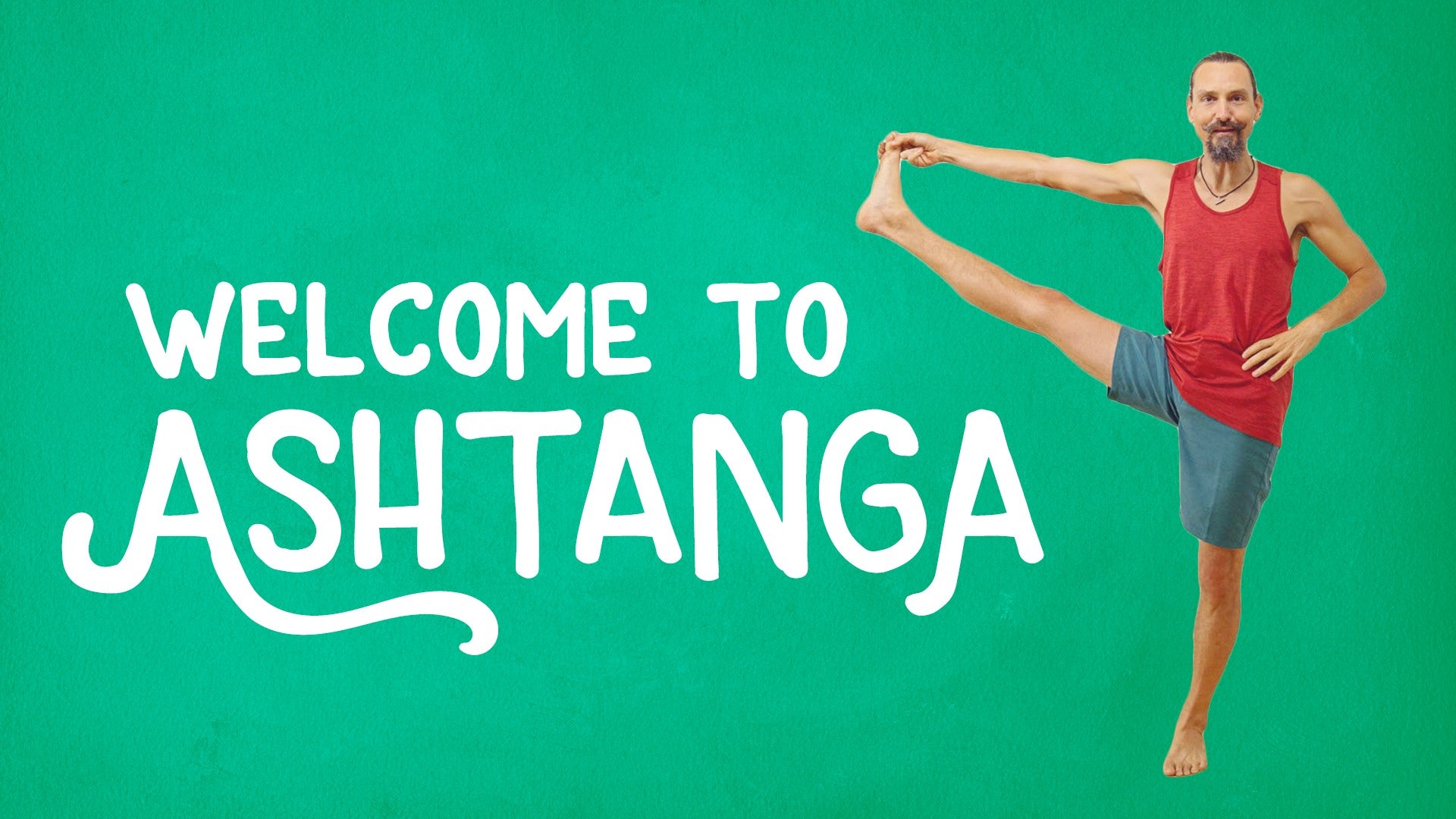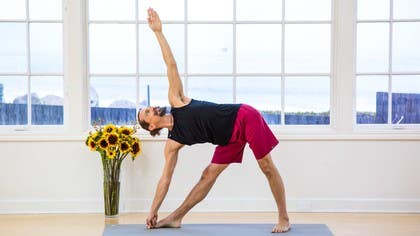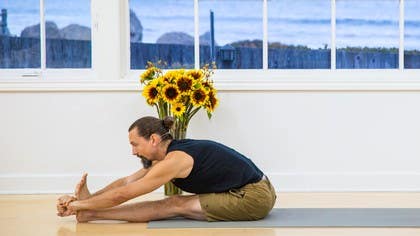Description
About This Video
Transcript
Read Full Transcript
Welcome to the fundamental asanas. It is sometimes said that this group of asanas contains the entire ashtanga practice in a shortened form. So now that you've become conversant and familiar with sun salutation A and B, we'll begin with those and then move into these standing poses. Start in samastitihi at the top of your mat. The feet are together, the kneecaps lightly lifted, mula and udiyana bandha rising up the center, the shoulders rolled back and down, and the tailbone slightly descending down towards the heels. Take an inhale, exhale completely here. Surya namaskara A begins, A can inhale, spread the collarbones and feel the hands float up, watch them meet together. Dway exhale, folding forward, dropping the head, grounding the palms. Trini and heel, head up, long spine, look forward, and chattwari. Exhale, step or jump, spin lower down to any chaturanga variation that serves you. Pancha, inhale, flattening the feet on the ground and finding baby cobra or upward facing dog. Shat, exhale, lifting the hips to the back corner of the room and downward facing dog. One, remembering that your breath is the absolute central mover of this practice. Two, so your awareness should always be resting back upon the breath. Three, the deep full complete exhalations can help you find the bandhas, the internal energy locks. Four, and try to keep both bandhas maintained and restrained through the breath cycle. Five, sapta, inhaling, stepping or jumping the feet forward, the head lifts, the spine is long. Ashta, exhale, fold forward, grounding the palms if that's available to you. Nava, inhale, rising up, still inhaling, see the thumbs meet. And exhale, right back to your neutral samastitihi. Ekam, inhale, arms up. Dway, exhale, fold forward. Trini, inhale, the head lifts, the spine lengthens, the collarbones are broad. And chattwadi, exhale, stepping or jumping, lowering down to chaturanga, tailbone down. Pancha, inhale, upward facing dog. Chattu, exhale, downward facing dog, settling into your comfortable downward dog there. One, spreading the fingers and spreading the toes. Two, notice that you're grounding through the root knuckles, the index mound and big toe mounds. Three, grounding deeply on the mat. Four, keeping the spine in line with the arms. Exhale, completely. Five, sapta, inhale, stepping or hopping the feet forward, head up. Ashta, exhale, folding forward, letting the head drop completely. See your nose and look towards your nose. And nava, inhale, rising up, seeing the hands meet, wrapping the tricep area forward to the face. Exhale, samastitihi with that broad collarbone experience. Last one, Ekam, inhale. Dway, exhale. Trini, inhale, head up. Chattuadi, exhale, jump back, keeping the collarbones broad. Pancha, inhale, the chest forward through the shoulders. Chattuadi, exhale, finding downward facing dog. One, hearing the sound of your breath. Two, as it reminds you to draw awareness onto the Bandhas and onto the breath. Three, wrapping the tricep area forward to the face so you feel the shoulders melt away from the ears. Four, five, sapta, inhaling, stepping or jumping the feet forward, head up. Ashta, exhale, folding forward, deeply, grounding the palms if that's available. Nava, inhale, rising all the way up. See your thumbs meet. Exhale, samastitihi.
Surinamaskar B, Ekam, inhale, bend the knees, hands up, see thumbs. Dway, exhale, fold forward, drop the head, look towards your nose. Trini, inhale, head up, look forward. And Chattuadi, exhale, step or jump, lower down to any Chaturanga. Punch, inhale, upward facing dog. Chattu, exhale, downward facing dog. Having arrived in down dog, sapta, inhale, step the left heel down, the right foot forward, arms up, see your thumbs. And Ashta, exhale, the hands down, the right foot back to Chaturanga. Nava, inhale, upward facing dog. Darsha, exhale, downward facing dog. Ekarasha, inhale, left foot forward, the right foot pressing into the mat behind, see your thumbs meet. Dwarasha, exhale, chatturanga dandasana. Triyugdisha, inhale, upward facing dog. Chattugdisha, exhale, into downward facing dog. One, long, smooth, fully breathing with sound. Two, the eyes stabilizing, looking softly onto any still point. Three, while the mind keeps journeying to the internal drishti, the bandhas and the breath. Four, exhaling completely. Five, pancharasha, inhale, step or jump the feet forward, head up, shodhasha, exhale, and fold. Saptarasha, inhale, bend your knees together, swing up the hands together, exhale, stand tall and samastitihi. Ekam, inhale, bend your knees, hands up. Dway, exhale, fold forward, drop the head.
Triyugdisha, inhale, head up. Chaturanga, exhale, jump back, chatturanga. Pancha, inhale, upward facing dog. Shodh, exhale, downward facing dog. Sapta, inhale, right foot forward, hands up, see your thumbs. Ashta, exhale, all the way to chaturanga, the elbows in, the collarbones brought. Inhaling the chest through the shoulders to upward facing dog. And dasha, exhaling to downward facing dog. Ekarasha, inhale, left foot forward, hands together, keeping the shoulders down. Dwayarasha, exhale, chaturanga dandasana. Triyugdisha, inhale, upward facing dog. Chaturagdisha, exhale, downward facing dog. One, every exhalation gives you that great golden moment, that great opportunity. Two, to find udiyana bandha and mula bandha, drawing awareness back to your very center. Three, so you can feel the breath rising and expanding the ribcage of every inhalation. Four, always bringing awareness back to your breath. Five, panjarasha, inhale, step or jump the feet forward, the head lifts, the spine is long. Shodhasha, exhale, folding forward, dropping the head. Saptarasha, inhale, bend your knees, squeezing them together, see the hands meet. Exhale, slowly stand tall to find samastitihi. One more, just counting in Sanskrit. Ekam, inhale, dweh, exhale, trini, inhale, chaturadi, exhale, pancha, inhale, shara, exhale. Sapta, inhale, right foot forward, hands up, see thumbs. Ashta, exhale, chaturagdha.
Nava, inhale, upward facing dog. Tasha, exhale, downward facing dog. Ekadasha, inhale, left foot forward, see your thumbs, dweh, exhale, chaturagdha. Chaturagdha, inhale, upward facing, chaturagdha, exhale, downward facing dog. One, two, three, still melting the shoulders away from the ears. Four, by rolling the triceps forward to the face. Five, pancha, rasa, inhale, jump forward, head up, shodhasha, exhale, forward fold, drop in the head. Saptarasha, inhale, bend your knees, seeing your hands rise up, the triceps roll forward, shoulders down, exhale, samastitihi at the top of the mat. Fundamental asanas, inhale, jump your feet about a hips distance apart, and then exhaling, fold forward. You may grab your big toes, two fingers inside each big toe, or if you can't comfortably reach them, you may be bending the knees to do so, or your hands may just be somewhere on the shins, any of those options is fine. And then, parangusthasana begins, Ekam, inhale, lengthen the spine, straighten the arms, see if you can pull your upper back long, still broadening the collarbones by rolling the shoulders back and down, and then Dway, exhaling, fold forward, keeping that length through the upper back. If you need to bend the knees to grab the toes, you could feel free to do that. One, the head is just dangling and the drishti or the eyes are gazing towards the nose. Two, if you're very comfortable in the posture with straight legs and holding your big toes. Three, remember to keep the kneecaps lifted, so you're drawing yourself with strong legs. Four, and you may be drawing yourself forward, leaning a little weight forward towards the fronts of the feet, exhaling completely. Five, trini, inhale, the head up, long spine, straighten the arms completely as you look forward. Exhale here. Parangusthasana begins putting your hands under your feet. Again, it may be that you need to bend the knees to get the toes all the way to the crease of the wrist. That's fine, but try to get your entire hand flat, so the backside of your hand is completely flat on the mat, even if the knees need to bend to do so. Ekam, inhale, lengthen the spine, head up, look forward and exhale, drop the head towards the mat, gazing towards the nose and breathe. One, two, the elbows may reach a little bit slightly back towards the legs, but not touching them. Three, so that you can keep the shoulders rolling away from the ears. Four, and again, if you're very comfortable here with the backs of the hands on the mat and straight legs, you might be leaning weight forward, the hips coming forward towards the fronts of the feet. Five, trini, inhale, head up, long spine, look forward. Exhale here. Inhale, coming up, you may bend the knees slightly on your way up, then straightening and exhale, always bringing yourself right back into samastitihi, the neutral position at the top of the mat. Utittatrikonasana A, Ekam, inhale, step your right foot towards the back of the mat, keeping the heels in a line, and pivot on your right heel, so the right toes face towards the back of the room. Dway exhaling, reach out over the right thigh. Try to keep your torso above your thigh. Maybe the hand just dangles lightly touching the right leg as you gaze towards the wall, ceiling, or even towards the left thumb. One, it may be that you're comfortable to even reach the hand down towards the foot. Two, but do try to keep your torso above your thigh. Three, it might be that you're able to even grab the big toe. Four, trying to keep your tailbone still and neutral pointing down. Five, three, inhale, come up, pivot upon your heels back to neutral, and then pivot on your left heel, so the distance stays the same step. Chaturthi, exhale, reach the left torso out over the left thigh, letting the hand dangle or hang, looking towards your right thumb. One, or you might be comfortable reaching all the way to take your left big toe. Two, but if you feel like taking the toe disturbs the lumbar spine or it feels too deep in the hip.
Three, also feel comfortable with the hand just dangling. Four, try not to rest too much weight down through your left hand, just keep it lightly touching. Five, punch your inhale, come up, pivot on your heels, and now B, pivot on your heels in such a way that the hips square towards the back of your room. With your next exhalation, fold forward with a flattened spine, a nice long spine, and then drop your left hand down towards your right foot. You can reach the right shoulder above the left, creating twists through the spine. One, and if it's comfortable, install the upper right hand just above the shoulder. Two, it may be that you can start to plant the left hand down on the mat. Three, eventually even reaching the left hand outside the right foot. Four, and trying to feel the shoulders stack above one another as you gaze upwards towards the right thumb. Five, punch your inhale, come up, moving your feet through the neutral position, and then squaring the hips to face towards the front of the room. Chaturi, exhale, folding forward, keeping the hips in neutral, keeping the spine long, and drop the right hand down, drawing the left shoulder above the right, and installing the left hand just above the shoulder. One, avoid the temptation to reach the left hand deeply back. Two, instead be restrained, keeping the left hand only above the left shoulder. Three, and try to draw the left shoulder itself above the right. Four, exhale completely. Five, punch your inhale, come up, the feet parallel, the arms out to the side, and exhale, step back to samastitihi at the top of your mat. Utita parsvakonasana, ekam, inhale, and step your right foot in a long step towards the back of your mat, your heels stay in a line, and then pivot upon your right heel, and exhale, bend the right knee deeply so that it comes all the way above the ankle, either with your right forearm down upon your right knee, or your right hand down outside the foot, grounding the palm if that's available to you. Install the upper left arm. One, reaching it so it feels like it's in the same line with your back left leg. Two, and as you continue to bend that right knee just above the foot. Three, find the whole torso, the chest spinning open. Four, and wrapping the left tricep forward to the face to relax the shoulder. Five, trini, inhale, come up, pivoting on the feet, to change the side, chatwari, exhale, bend your left knee deeply, the left forearm might ground upon the knee, the right arm installed and lifting towards the corner of the room. One, again if it's comfortable to you, you can drop the left hand just outside the left foot. Three, keeping the left toes and fingers in the same line. Four, seeing that the hand doesn't reach in front of the foot but it's drawn back just beside it. Five, punch it, inhale, come up, and pivot on your feet to change the side, facing towards your right leg. Begin parivritta parsvakonasana with the left leg still straightening back into the mat. As you exhale, bend your right knee very deeply, very completely. Breathing as needed, find an exhale that draws the left shoulder over the right knee, plant the hands together and twist the spine. One, to lift the gaze up towards the ceiling. Two, feel free to bend the right knee more deeply, making sure that you can really twist three, and if you can keep the shoulder locked over the knee, drop the left hand down outside the right knee, and install the upper right arm. Four, gazing into the center of the right palm, making sure there's no gap between the knee and shoulder. Five, trini, inhale, come up, keeping the step long, and chaturwadi exhale, bending the left knee deeply, keeping the right foot flat upon the mat, getting your right shoulder all the way locked over the left knee. One, and then installing the left arm, gazing to the center of the palm. Two, if you were taking this posture and found that some gapping occurred and you no longer had the ability to push off the knee, three, no problem, just keep the left knee bent and instead use the hands pressing together for keeping the right shoulder pressing on the left knee to twist. Five, punch it, inhale, come up, feet parallel and arms out, exhale back to samasthiti at the top of the mat. Prasadita parottanasana A, Ekam, inhale, take a step with your right foot and your feet parallel. Hands go onto your waist and exhale, folding forward, put the hands down in between the feet, again inhale, the head up, the spine long, look forward. Trini, exhale, drop the top of the head. So keeping your hands spreading just like chaturanga, one, the elbows remain in close, just above the wrists, two, and again if you're comfortable with straight legs, leaning weight forward, three, if you need to bend the knees to protect the hamstrings or lower back, feel free, four, five, chaturthi, inhale, a long spine, head up, look forward, exhale here, just exhale and punch it, inhale, coming up you can bend the knees to round the spine a little on the way up, catch your waist and exhale. B, Ekam, inhale, the arms out to the side, the shoulders rolling back and down, Dwe exhale, the hands take the waist, fingers pointing towards udiyana bandha, again inhale with the tailbone still down, the chin down, lift the chest, and train the exhale folding forward, keeping that length through the upper spine as you gently begin to drop the head, one, and if it feels like the upper back is hunching and rounding, two, instead take the position higher but try to keep length through the upper back, three, it may help you to draw the elbows back further behind you for using the shoulder blades to help keep that length in the upper spine, fingertips still on udiyana bandha wrapped around the hip, five, Chaturthi, inhale, come all the way up and exhale here, C, Ekam, inhale, the arms out to the side, Dwe exhale, interlace the fingers behind the sacrum, again inhale lengthening the arms and train the exhale fold forward, dropping the head towards the mat and letting the hands rise away from the sacrum, one, if you can keep moving the hands with straight arms away from the sacrum, fine, two, if it starts to feel like there's a too much pressure on the elbows, micro bend the elbows, three, as the hands keep coming deeper, four, and again you can lean weight forward towards the fronts of the feet, five, Chaturthi, inhale, come all the way back up and exhale here, hands take the waist, begin Prasarita D by inhaling, lifting the chest, and Dwe exhale folding forward, grabbing your big toes if that's available to you or taking the ankles or the shins if that's all you got, again inhale, long spine head up, look forward and train the exhale drop the top of the head, one, if you can take the big toes, two, you may be gently pulling on the toes, keeping the elbows spreading apart from one another, three, as weight comes forward towards the front of your mat, four, keeping the kneecaps lifted, strong legs, five, Chaturthi, inhale, the head up, the long spine, look forward, exhale here, then Pancha, inhale, come up, again you might bend the knees to find it more easy to rise, and exhale, take Samastitihi, feet together at the top of the mat, Parsvottanasana, Ekam, inhale, and let's have you take the pinkies up the back of the spine, ideally on the same inhale, you would step your right foot into a small step towards the back of the mat, and ideally still breathing, but ideally on the same inhale, you'd pivot and square your hips all the way to face the right side, and do an exhale folding forward over your right foot, looking on to the right big toe, one, let the pinkies do some spying on the upper back, two, seeing if there's any position where it wants to hunch or fold, three, and reminding yourself to keep the upper back flat even as you fold forward, four, spreading the toes, keeping grounding through the root knuckles of the feet, five, Trini, inhale, come up, pivot on the heels, change the side, keep the step the same distance, squaring the hips towards the left side, Chaturwadi, exhale, folding forward with the long spine, letting the chest lead the way forward, letting the shoulders lag behind, one, so as the shoulders get dragged by the chest, two, they keep that broad collarbone experience available, three, four, spreading the toes and grounding through the big toe mounds, exhale completely, five, and punch, inhale with straight legs and strong legs, come up, release the arms, spreading wide, and exhale back to samastitihi at the top of the mat. Wonderful work, you've completed the fundamental asanas there, keep reviewing them, keep familiarizing yourself with them, through this daily practice of ashtanga, the poses will become deeper, but also your understanding and appreciation for them will become deeper. Once you feel familiar with those postures, then you can move on to the one-legged standing balance and complete the standing sequence. Wonderful, keep practicing, keep in touch, look forward to hearing from you.
Welcome to Ashtanga
Comments
You need to be a subscriber to post a comment.
Please Log In or Create an Account to start your free trial.






















